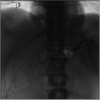Splenic artery steal syndrome after liver transplantation - prophylaxis or treatment?: A case report and literature review
- PMID: 35909087
- PMCID: PMC9721243
- DOI: 10.14701/ahbps.22-004
Splenic artery steal syndrome after liver transplantation - prophylaxis or treatment?: A case report and literature review
Abstract
Splenic artery steal syndrome (SASS) is a cause of graft hypoperfusion leading to the development of biliary tract complications, graft failure, and in some cases to retransplantation. Its management is still controversial since there is no universal consensus about its prophylaxis and consequently treatment. We present a case of SASS that occurred 48 hours after orthotopic liver transplantation (OLTx) in a 56-year-old male patient with alcoholic cirrhosis and severe portal hypertension, and who was successfully treated by splenic artery embolization. A literature search was performed using the PubMed database, and a total of 22 studies including 4,789 patients who underwent OLTx were relevant to this review. A prophylactic treatment was performed in 260 cases (6.2%) through splenic artery ligation in 98 patients (37.7%) and splenic artery banding in 102 (39.2%). In the patients who did not receive prophylaxis, SASS occurred after OLTx in 266 (5.5%) and was mainly treated by splenic artery embolization (78.9%). Splenic artery ligation and splenectomies were performed, respectively, in 6 and 20 patients (2.3% and 7.5%). The higher rate of complications registered was represented by biliary tract complications (9.7% in patients who received prophylaxis and 11.6% in patients who developed SASS), portal vein thrombosis (respectively, 7.3% and 6.9%), splenectomy (4.8% and 20.9%), and death from sepsis (4.8% and 30.2%). Whenever possible, prevention is the best way to approach SASS, considering all the potential damage arising from an arterial graft hypoperfusion. Where clinical conditions do not permit prophylaxis, an accurate risk assessment and postoperative monitoring are mandatory.
Keywords: Graft hypoperfusion; Nonocclusive hepatic artery hypoperfusion; Splenic artery steal syndrome; Steal syndrome.
Conflict of interest statement
No potential conflict of interest relevant to this article was reported.
Figures




Similar articles
-
[The risk factors of splenic arterial steal syndrome after orthotopic liver transplantation].Zhonghua Wai Ke Za Zhi. 2015 Nov 1;53(11):836-40. Zhonghua Wai Ke Za Zhi. 2015. PMID: 26813838 Chinese.
-
Evolving experience with prevention and treatment of splenic artery syndrome after orthotopic liver transplantation.Transpl Int. 2010 Aug;23(8):831-41. doi: 10.1111/j.1432-2277.2010.01062.x. Epub 2010 Feb 18. Transpl Int. 2010. PMID: 20180930
-
New strategies for prevention and treatment of splenic artery steal syndrome after liver transplantation.World J Gastroenterol. 2014 Nov 7;20(41):15367-73. doi: 10.3748/wjg.v20.i41.15367. World J Gastroenterol. 2014. PMID: 25386086 Free PMC article. Clinical Trial.
-
Splenic Artery Embolization for Splenic Artery Steal Syndrome After Living Donor Liver Transplantation: A Case Report.Transplant Proc. 2022 Dec;54(10):2772-2778. doi: 10.1016/j.transproceed.2022.09.020. Epub 2022 Nov 12. Transplant Proc. 2022. PMID: 36376105 Review.
-
Splenic Artery Syndrome after orthotopic liver transplantation: a review.Int J Surg. 2014 Nov;12(11):1228-34. doi: 10.1016/j.ijsu.2014.09.012. Epub 2014 Oct 12. Int J Surg. 2014. PMID: 25311773 Review.
Cited by
-
Gastroepiploic artery embolization for splenic trauma in a liver transplant recipient.J Clin Imaging Sci. 2025 May 20;15:18. doi: 10.25259/JCIS_3_2025. eCollection 2025. J Clin Imaging Sci. 2025. PMID: 40469745 Free PMC article.
-
Exploring the topography of the splenic artery: a comprehensive analysis.Surg Radiol Anat. 2025 Mar 30;47(1):108. doi: 10.1007/s00276-025-03622-y. Surg Radiol Anat. 2025. PMID: 40159348
-
Celiac trunk angiography with balloon occlusion of splenic artery for diagnosis and treatment of splenic steal syndrome.Radiol Case Rep. 2024 Dec 15;20(3):1354-1358. doi: 10.1016/j.radcr.2024.11.052. eCollection 2025 Mar. Radiol Case Rep. 2024. PMID: 39791122 Free PMC article.
-
Splenic artery steal syndrome after liver transplantation: A case series and review of literature.Clin Case Rep. 2024 May 13;12(5):e8930. doi: 10.1002/ccr3.8930. eCollection 2024 May. Clin Case Rep. 2024. PMID: 38745733 Free PMC article.
References
-
- Grieser C, Denecke T, Steffen IG, Avgenaki M, Fröhling V, Mogl M, et al. Multidetector computed tomography for preoperative assessment of hepatic vasculature and prediction of splenic artery steal syndrome in patients with liver cirrhosis before transplantation. Eur Radiol. 2010;20:108–117. doi: 10.1007/s00330-009-1535-y. - DOI - PubMed
Publication types
LinkOut - more resources
Full Text Sources
